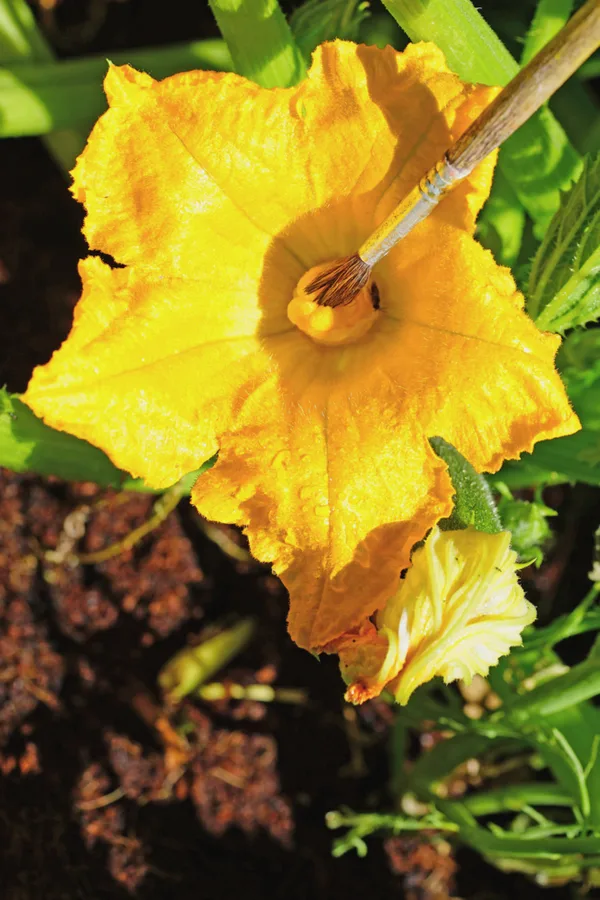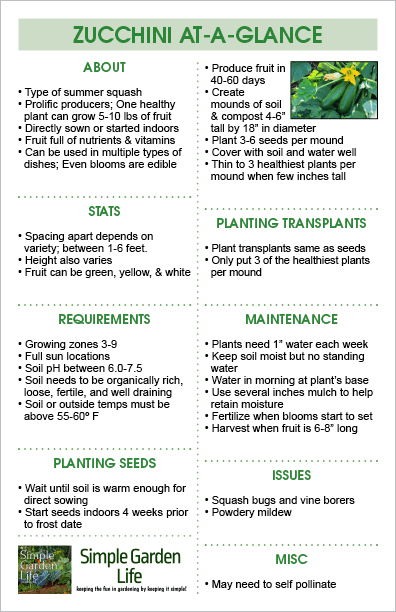If you are looking to grow a plant that will not only produce an abundance of fruit, but one that is delicious and able to be utilized in a variety of recipes, then zucchini is the one for you!
Zucchini is the perfect plant for getting the most bang for your buck. A single healthy zucchini plant can produce between 5 to 10 pounds of vegetables in a single growing season. It’s likely that you will be left with more zucchini than you know what to do with.
Thankfully, your friends, family, and neighbors are usually more than happy to help take some off of your hands!

Their fruit can be shredded and baked into delicious bread, turned into sweet and spicy relish, or even sauteed with ground beef for a delicious weeknight meal. Their beautiful yellow and orange blooms are even edible as well!
While you may not realize it, zucchinis are also extremely healthy, too. They are packed full of vitamins and fiber. Potassium; vitamins A, B, and C; magnesium; zinc; antioxidants; and Omega-3 fatty acids are just a few of the wonderful benefits you receive when consuming zucchini.
Zucchini plants can be grown in zones 3-9. (To find your growing zone, just check Here.) By following these few simple tips and tricks, you can help to keep your zucchini plants healthy. In return, they will reward you with an amazing harvest throughout the entire growing season.
Zucchini Varieties – How To Grow Zucchini
Zucchini is a type of summer squash. Although there are a few different varieties of summer squash, they are all basically handled similarly when it comes to planting. In addition, they all have similar flavor profiles as well as textures when it comes to consumption.
Most zucchini fruit comes in shades of light and dark green. But there are some varieties that are yellow and even almost white. Popular varieties include Dark Green, Black Beauty, and Golden Zucchini.
Most zucchini plants start off growing like a bush. As they mature, the thick stems start to take off from their central location. Because of these traveling stems, the plants take up a lot more space than you might think.

Bush varieties of zucchini will need around 1 to 4 feet of space while more vining varieties will need around 6 feet to grow. Be sure to check your seed packet prior to planting to ensure you are giving your crop plenty of space. Adequate space equals healthier plants and more fruit for you to harvest!
How To Plant, Grow, And Maintain Zucchini
Soil Requirements for Zucchini
Zucchinis require organically rich, loose fertile soil. It should be slightly acidic to neutral, with a soil pH of around 6.0 to 7.5. Amend soil with plenty of compost prior to planting for best results.
In addition, the soil needs to be able to drain well since excess standing water can cause a whole slew of issues. Be sure to consider crop rotation as well. Planting zucchini in the same location year after year is asking for an increase in pests and diseases.
Timing Is Everything
Zucchini plants cannot live through colder temperatures and especially frost. Since zucchini plants prefer warm environments, ensure that you don’t plant them too early. It is best to wait until at least late spring for most locations.
To ensure plants have the best chance at survival, do not plant seeds or transplants until the outside temperatures and your soil temperatures reach at least 55 to 60º Fahrenheit (13 to 16º Celsius).
Planting Zucchini
These robust producers can be directly sown or started indoors. It takes about 40 to 60 days from planting until maturity, so either way works well for most growing locations.
However, if you have a shorter growing season with cooler spring temperatures, it might be best to give your plants a head start. Start them indoors and then plant once the temperatures warm up past the danger zone.

Preparing Your Location
As emphasized earlier, be sure to wait until all of the danger of a late frost has passed for your location no matter whether you are planting seeds or transplants. To help raise the soil’s temperatures, you can lay black plastic on top of the soil for a few days.
If you are really patient, you may even choose to wait until the middle of summer before planting. This will help you avoid certain early-spring pests and issues like squash vine borers that can bother zucchini plants.
No matter when you decide to plant, pick out a location that receives full sun. Avoid planting near potatoes and other cucurbits. Also, be sure to keep spacing in mind when you choose your location as well.

Zucchinis grow best when planted in mounds or hills. Using a mixture of compost and soil, create a mound that is around 4 to 6 inches tall and around 18 inches in diameter. The added compost will help to give the plants a good head start with growing healthy and strong.
The distance apart that you place the mounds will depend on the variety of zucchini you are growing. Again, more space is better to allow for good air flow and sunlight to the crop.
Direct Sowing
For direct sowing, space 3 to 6 seeds equally apart within each mound. Lightly cover with soil and water well. After the plants have germinated and are a few inches tall, thin to only the 3 healthiest-looking plants per mound.
Planting Transplants
For transplants, start your seeds indoors about 4 weeks before your last expected frost date. Dig three small holes in each mound that are deep and wide enough for the transplant’s roots. You want only the three healthiest plants in each 18” mound. Cover lightly with soil and water well.

Long-Term Care – How To Grow and Maintain Zucchini
While zucchini plants aren’t difficult to grow, there are a few things to consider if you want your plants to thrive. Following these tips will help to ensure that you end up with a great harvest this growing season!
Watering
Since zucchini fruit is made up of mostly water, they require moist soil. Keep in mind that moist soil is different than standing water. You want the soil about 3 to 4 inches below the surface line to be moist but you don’t want actual puddling to happen around the plant’s base.
Ensure that each plant is receiving at least 1 inch of rainfall or direct watering each week. This is especially important while the plants are actively producing fruit.
If hand watering, be sure to water the plant at the base and not overhead. A soaker hose is a great option to consider with zucchini plants. In addition, water in the early morning for best results.
Mulching
A great way to help conserve moisture is to mulch around each zucchini plant. After the plants are a few inches tall, add a few inches of natural mulch such as straw, grass clippings, or shredded leaves. The mulch will help to retain moisture in the soil as well as help to cushion the fruit and keep them free of blemishes.

Fertilizing
After you start to see the first few blooms appear on your zucchini plant, it’s a good idea to apply a dose of an all-purpose, liquid fertilizer. Apply early in the morning to avoid the fertilizer burning the tender plants during the heat of the day.
As an alternative, you can use compost tea or worm casting tea as well for a 100%, all-natural liquid fertilizer. Check out those links for in-depth information about the wonderful benefits of these two organic fertilizers and how they might benefit your plants.
Lots Of Blooms But No Fruit?
Each zucchini plant produces both male and female blooms. The female blooms will have a small bulge behind the flower. If fertilized, this bulge will turn into the zucchini fruit. Male blooms, on the other hand, have shorter stems and no bulge.
If your plant is covered in blooms but you are struggling to find any fruit, proper pollination is likely the problem. The female blooms have to be fertilized by the pollen in order to actually produce fruit.

Lack of bees might be at the root of the problem. No bees equal no blooms being pollinated. While you can add flowers and plants that attract pollinators around your zucchini plants, there is another way you can help your zucchini blooms out as well: you can pollinate them on your own!
Zucchini blooms are open during the nighttime. So early in the morning while the blooms are still open, identify the male and female blooms.
Take a cotton swab, q-tip, or small paintbrush to gather the pollen from the stamen of the male flower onto your swab or brush. Then, carefully apply it to the base of the stigma in the female flower. It’s really as simple as that!
Pests
Even though zucchini plants are fairly simple to grow with good soil and adequate watering, there are some pests to keep an eye out for.
The number one pest for zucchini plants is the dreaded squash bug. These bugs eat the sap of the plant, making it weak. They also secrete a toxin that can be deadly to plants. To learn exactly how to get rid of these pests, check out this article, “How To Ged Rid Of Squash Bugs From Your Garden.”
Another invasive pest is the squash vine borer. These insects hid out in the soil over winter and come up during early summer. They will lay their eggs at the base of the zucchini plant. After hatching, the larvae dig into the stem, causing it to rot and the foliage to wilt.
If squash vine borers have been an issue in your garden in the past, one of the best things you can do is hold off on growing zucchini or other summer squash for a year, or find a new location entirely.
Alternatively, you can put off planting your zucchini until mid-summer, past the date of the adults emerging. Another trick to help save your zucchini plants is to wrap the base of the stem tightly in newspaper to prevent the larvae from burrowing into the stem. Just make sure to remove the wrapping in mid-July.
Powdery Mildew
The other main issue that might arise with zucchini plants is powdery mildew. This fungal disease creates a white powder-like coating on the leaves. If you see this, remove any affected foliage and discard it.

Harvesting The Fruit – How To Grow Zucchini.
You’ve likely seen images of massive zucchini fruit before. If left unchecked, they can grow to amazing sizes! However, for most varieties, it is best to harvest zucchini when they are around 6 to 8 inches long. If they grow too large, the seeds will become large and the rind will turn tough.
Take a sharp knife or garden shears to cut the fruit’s stem, leaving about 1 inch of stem attached. The more you harvest, the more the zucchini will produce. Most plants will continue to put on fruit until the first frost in the fall.
To Conclude…
With all of these tips and suggestions at your disposal, you will be on your way to enjoying an amazing bumper crop of healthy, delicious zucchini this growing season! Just make sure you have a few people in mind whom you can share your harvest with!
Feel free to download, print out, or save our Zucchini At-A-Glance sheet. It is sized for half letter printing but can be scaled if needed.
Follow Our Facebook Page For Even More Great Tips! Simple Garden Life Facebook Page
Simple Garden Life is a website dedicated to keeping gardening fun, simple and enjoyable! We publish two new articles each week along with a new garden podcast episode every two weeks. This article may contain affiliate links.
